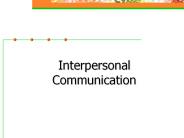Communication as culturally contexted practice - PowerPoint PPT Presentation
1 / 12
Title:
Communication as culturally contexted practice
Description:
Context is both linguistic and non-linguistic. ... grammar/ vocabulary/ pronunciation/ kinesics. norms of interaction. pragmatic norms ... – PowerPoint PPT presentation
Number of Views:78
Avg rating:3.0/5.0
Title: Communication as culturally contexted practice
1
Communication as culturally contexted practice
- Anthony J. Liddicoat
- Research Centre for Languages and Cultures
Education - School of International Studies
- University of South Australia
2
Language, culture and communication
- Communication is not simply an act of language
use. - Communication occurs in a context.
- Context is both linguistic and non-linguistic.
- Culture is a contextual factor which shapes
language and communication.
3
Culture impacts on communication at a number of
levels
Source Crozet and Liddicoat (1999)
4
Culture as frame
- Culture constitutes a frame in which meanings are
conveyed and interpreted. - Culture gives specific, local meanings to symbols
and associations connotations with denotations.
5
Culture as frame
- Sacred Site
- Anthropological discourses e.g. a location with
ritual significance. - Political discourse ownership.
6
Culture and text
- Culture also influences how the linguistic act
itself is constructed - text types
- the properties of textual structures
- the purposes of textual structures.
- Aspects of communication such as sequencing,
recipient design and impact are read within a
framework of cultural understandings about valued
and appropriate language use.
7
Culture and text
- Different ways of organising text are valued in
different cultures these norms for organising
text affect how people perceive the text
aesthetics, logic, coherence, clarity. - In French academic writing, digression shows
depth of knowledge, in English it shows lack of
focus. - In German academic writing, the text works from
less important arguments/information to more
significant arguments/information, in English
this order is reversed. - In Japanese kishoutenketsu ???? style involves
introducing a point (ki ?), elaborating the point
(shou ?), changing to a tangentially related
sub-theme (ten ?) and concluding (ketsu ?). This
structure is elegant in Japanese, but the ten
section seems an irrelevant tangent in English.
8
Culture and text
- Different cultures place the responsibility for
text comprehension on different participants in
the discourse writer/speaker or reader/listener
(Hinds 1987). - Writer responsibility (English) the writer is
responsible for ensuring that the text is clear,
coherent and comprehensible to the reader more
overt structuring, more establishment of shared
knowledge. - Reader responsibility (Japanese) the reader is
responsible for making meaning from the writers
text less overt structuring, greater assumption
of shared knowledge.
9
Culture and purpose
- Son Hi Mum thanks for picking me up.
- Mother Thanks for picking you up! Did you think
I wasnt going to come? But Im your mum, of
course I was going to come. Its dark and youre
little. Of course I was going to pick you up.
- Mother French
- French understanding thanking in family contexts
is done for things which are extra, the sons
thanks is heard as a criticism.
Son Australian Australian understanding
expressing appreciation for a kindness (polite).
Mothers reaction is unexpected.
10
Culture and purpose
- All languages use routine and formulaic
utterances in social interaction. - E.g. English How are you?
- Routines often have conventionalised responses.
- Eg. English Okay/Fine. Departures from the
conventions are subject to social
interpretations Not so good/terrible and have
interactional import.
- A routine in one language may not be a routine in
another Did you have a good weekend? cf Tu as
passé un bon weekend?
11
Culture and form
- Linguistic acts are made up of meaningful
elements lexicon, morphology, syntax, etc. - Meanings are culturally contexted and are
realised in culturally specific ways.
- Llámame cuando llegas. (indicative)Call me when
you arrive. - Llámame cuando llegues. (subjunctive)Call me
when you arrive.
- English you
- French tu, vous
- Spanish tu, usted, vosotros, ustedes, vos
- English give
- Japanese kudasaru ???, kureru ???, ageru ???,
sashiageru ?????.
12
Language, culture, communication and translation
- Communication involves the use of a culturally
shaped code in a culturally shaped context. - This leads to problems of translatability it is
possible to translate at the level of code from
one language to another, however the meanings
communicated vary because of the new layers of
cultural shaping.































